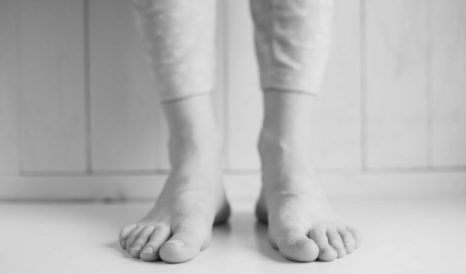Hallux Rigidus (Arthritis in Toes) – Treatment & Surgery
In his latest article, Simon Moyes discusses Hallux Rigidus (Arthritis in Toes), how it caused, possible symptoms and treatment options.
Pain and stiffness at the base of your big toe is often caused by a condition called hallux rigidus. An injury to your big toe joint can lead to arthritis – a degenerative bone condition that results in pain, stiffness and swelling.
Hallux rigidus can have a major impact on walking, squatting, running and many other daily activities.
If you suspect that you have hallux rigidus, it’s a good idea to get it checked out so that you can start treatment, and ideally take preventative measures before the joint becomes badly damaged.
What Is Hallux Rigidus (arthritis in the big toe)?
The main metatarsal bone of your foot connects to the big toe bone (phalanx) at the MTP (metatarsophalangeal) joint. As the MTP joint bends, it enables you to roll forward on your foot and push off.
The bones of your joint are coated in a smooth cartilage to enable smooth movement. This cartilage can get damaged or worn away due to repetitive high impact activities, wear and tear or imbalance in the structure of your foot.

Damaged cartilage can lead to the degenerative condition of osteoarthritis as the bones rub together.
The result is stiffness and swelling around the joint, causing pain and hindering movement. The condition often leads to bony outgrowths (bone spurs) – causing inflammation as they rub on the soft tissues around the joint, and preventing full range of movement.
The MTP joint is surrounded by a gel filled sac called a bursa. This can become thickened and inflamed due to pressure of bony outgrowths, causing more swelling.
What Causes Hallux Rigidus?
Some of the most common factors that lead to Hallux rigidus include:
Injuries, such as stubbing your toe or spraining the joint in your big toe, can contribute to osteoarthritis and lead to hallux rigidus.
Overuse: regularly stooping and squatting can cause overuse of the joint in your big toe. It also tends to affect people who play sport on artificial surfaces such as astroturf.
Medical conditions such as rheumatoid arthritis (inflammation of the soft tissues of your joints) and gout.
Abnormal foot structure – certain injuries, collapsed arches or genetic abnormalities can cause undue pressure on the MTP joint, leading to arthritis.
Those with a family history are more likely to develop hallux rigidus, and it tends to affect women more than men.
What are the Common Symptoms of Hallux Rigidus?
You will first be aware of the condition when you feel pain in the joint at the base of your big toe. It can be felt on the top or deeper inside the joint, depending on the location of the damage and pressure on soft tissues and nerves. If you have bony outgrowths, you will feel sharp pain, especially when wearing shoes.
The pain will often be accompanied by stiffness and the joint can become swollen.
You may unconsciously compensate for the lack of mobility by rolling your foot onto the outside, which can lead to problems elsewhere in your foot and ankle.
How is Hallux Rigidus Treated?
Even if you are not especially physically active, hallux rigidus needs to be treated, as it can eventually prevent you being able to walk.
A diagnosis based on your range of motion and pain on movement is usually backed up with an x-ray to determine the extent of the arthritis in your toe joint.
Anti inflammatories or steroids: used to relieve pain and swelling.
Orthotics: You may be given a special insole that takes the pressure off helps the MTP joint while encouraging it to bend fully.
Physiotherapy: Stretching exercises and manual manipulation can help to prevent your toe joint from stiffening up.
Surgery: In more severe cases, arthroscopic surgery may be necessary, usually to remove bone spurs and smooth off rough edges in the joint. In rare cases, a joint replacement using prosthetic parts may be necessary.
My advice is: look after your feet! Problems in the joints of your toes can lead to much bigger issues. Even a small pain in your big toe joint can lead to problems with your foot alignment and in the biomechanics of your entire lower leg.
Simon Moyes is an internationally renowned orthopaedic surgeon and leader in the field of arthroscopic (keyhole) surgery. His Capital Orthopaedics team works from The Cromwell Hospital in London, with its state-of-the-art diagnostic and surgical equipment, and top sports medicine professionals. Contact Simon Moyes for an expert diagnosis and treatment of all your foot and ankle problems.
